Some of my finest animations created with
Pov-Ray and (more recently) Blender
This is my first attempt at putting together a Demo R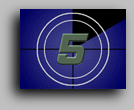 eel. I'm not a professional and I just did this for fun.
It's about 3.5 Megs and lasts just over one minute. I assembled the
whole thing within Blender's sequence editor. You will need to install
the DivX codec to view it. If you
are having problems with the format, let me know and I will post
another version in MPEG format (It will be about 5 Megs). Please send
me any comments, suggestions, or criticisms. I want to improve it and
add some sort of music. Any ideas?
eel. I'm not a professional and I just did this for fun.
It's about 3.5 Megs and lasts just over one minute. I assembled the
whole thing within Blender's sequence editor. You will need to install
the DivX codec to view it. If you
are having problems with the format, let me know and I will post
another version in MPEG format (It will be about 5 Megs). Please send
me any comments, suggestions, or criticisms. I want to improve it and
add some sort of music. Any ideas?
To the right is a 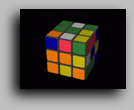 ray-traced animation of that famous puzzle from the
1980's known as Rubik's Cube. Watch the cube solve itself as it floats
in outer space. This is an old animation that I did in 1996, it used
to be a 6MB FLC, but now it is mpeg compressed and is around 700KB. It
has a total of 480 frames and was encoded with cmpeg. Read the mpeg
statistics for this animation. This
was rendered with Pov-Ray.
ray-traced animation of that famous puzzle from the
1980's known as Rubik's Cube. Watch the cube solve itself as it floats
in outer space. This is an old animation that I did in 1996, it used
to be a 6MB FLC, but now it is mpeg compressed and is around 700KB. It
has a total of 480 frames and was encoded with cmpeg. Read the mpeg
statistics for this animation. This
was rendered with Pov-Ray.
Here is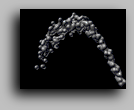 a 326KB test animation of a water fountain created with
Blender 1.80 (you will need to install the DivX codec to view it).
This is a perfect example of how efficient Blender's memory use is.
Blender can create this water fountain using blobs at the location of
each particle. This effect can also be created in Strata 3D, which is
also freeware. However, I can use more than 1000 particles in Blender
and still have memory to spare. Strata 3D runs out of memory with only
100 particles. In fact, I'll bet that just loading Strata 3D uses more
memory than Blender with all 1000 blob objects loaded!
a 326KB test animation of a water fountain created with
Blender 1.80 (you will need to install the DivX codec to view it).
This is a perfect example of how efficient Blender's memory use is.
Blender can create this water fountain using blobs at the location of
each particle. This effect can also be created in Strata 3D, which is
also freeware. However, I can use more than 1000 particles in Blender
and still have memory to spare. Strata 3D runs out of memory with only
100 particles. In fact, I'll bet that just loading Strata 3D uses more
memory than Blender with all 1000 blob objects loaded!
Here is a 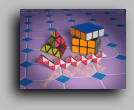 ray-traced animation of my favorite scene. You can get a
good look at each puzzle as the view rotates a full 360 degrees
(that's why it is known as a 360° turn table test). This one has
a total of 400 frames and—because of all the reflection and soft
shadows—took 5 hours and 30 minutes on a 450 MHz Pentium II. It
was compressed with mpeg2encode 1.2 and is around 2MB. Read the mpeg
statistics for this animation.
This was rendered with Pov-Ray.
ray-traced animation of my favorite scene. You can get a
good look at each puzzle as the view rotates a full 360 degrees
(that's why it is known as a 360° turn table test). This one has
a total of 400 frames and—because of all the reflection and soft
shadows—took 5 hours and 30 minutes on a 450 MHz Pentium II. It
was compressed with mpeg2encode 1.2 and is around 2MB. Read the mpeg
statistics for this animation.
This was rendered with Pov-Ray.
Here is a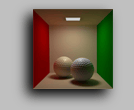 360° turn table test of my cornell golf scene.
Note how the specular highlights reflect off the dimples as the scene
rotates. I exported my radiosity solution to a wrl file (20MB), then
imported into Max4 (it took 10 minutes to import!). I added one point
light near the ceiling, and set it to not affect the diffuse
component, just the specular component. This was a very important and
necessary step in order to not disturb the radiosity solution. Two
formats available: DivX 1.7MB or
Mpeg 2.1MB. Quality is more or
less the same in both versions. There's also a standard cornell box
scene (no golfballs) here: DivX
2.1MB.
360° turn table test of my cornell golf scene.
Note how the specular highlights reflect off the dimples as the scene
rotates. I exported my radiosity solution to a wrl file (20MB), then
imported into Max4 (it took 10 minutes to import!). I added one point
light near the ceiling, and set it to not affect the diffuse
component, just the specular component. This was a very important and
necessary step in order to not disturb the radiosity solution. Two
formats available: DivX 1.7MB or
Mpeg 2.1MB. Quality is more or
less the same in both versions. There's also a standard cornell box
scene (no golfballs) here: DivX
2.1MB.
This page was last revised on Monday, March 22, 2004
Copyright © 2000-2004 Anthony D'Agostino
All rights reserved.